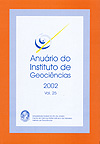Norito e charnoenderbitos da borda do maciço intrusivo de Venda Nova, Espírito Santo
DOI:
https://doi.org/10.11137/2002_0_99-124Abstract
An irregular and narrow ring of charnoenderbites and norite envelopes gabbros and syenomonzonites in the Venda Nova inversely zoned pluton, Espírito Santo. The former have an almost massive structure, with foliation only locally well marked. The norite is a fine-grained cumulatic rock with granular hypidiomorphic to intergranular texture. The medium-grained charnoenderbites comprise enderbites, Opx-quartzdiorites and Opx-granodiorites. They are leucocratic to mesocratic with granular hypidiomorphic to porphyritic texture. Ortho and clinopyroxene are present in the both lithotypes. Subsolidus textures occur in the norite and charnoenderbites. The whole rock chemistry separates two different sequences: a basic one, with tholeiitic affinities, correspond to the noritic cumulate, and an intermediary one, medium-K calc-alkaline, comprising the charnoenderbites. They show clearly different chemical signature when compared to the alkalic affinity rocks of the inner domain of the pluton. Both the sequences have similar geochemical characteristics: they are metaluminous, Ca, Fe and Al enriched, and have low to moderate incompatible elements contents. Normal to depleted mantle protolith is inferred for both sequences, and garnet probably was a residual phase during the mantle partial melting.Downloads
Published
2002-01-01
Issue
Section
Article
License
This journal is licensed under a Creative Commons — Attribution 4.0 International — CC BY 4.0, which permits use, distribution and reproduction in any medium, provided the original work is properly cited.
















 Except where otherwise noted, content on this site is licensed under a license
Except where otherwise noted, content on this site is licensed under a license 